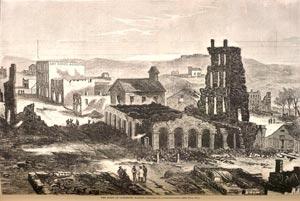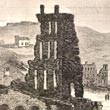The Civil War in Missouri
Save ThisMy CollectionThomas Ewing Jr.'s General Order No. 11

"Ruins of Lawrence, Kansas" (Download 2 MB PDF)
Highlights
- General Thomas Ewing Jr. received a command under General John Schofield in 1863. With his appointment to this position he faced a great challenge.
- He would have to deal with the rampant guerilla action on the Missouri-Kansas border, but also stop fighting between loyal Missourians and Kansas Jayhawkers under James Lane.
- On August 21, 1863, guerilla William Quantrill attacked Lawrence, Kansas, in what became one of the largest attacks on unarmed civilians in U.S. history.
- Lane and his Jayhawkers demanded retribution and began planning a return attack. General Ewing had already set in motion a plan to deal with guerrilla activity.
- He secured agreement from Lane to give his plan a chance to work.
General Order #11
Highlights
- On August 25, 1863, General Ewing issued his controversial General Order No. 11. This order required all residents of Jackson, Cass, Bates, and parts of Vernon counties to vacate them.
- Those who were Southern sympathizers had to leave Missouri for the Confederacy, while loyalists could find refuge in Federal military posts or other towns.
- Troops then reportadly burned houses, shops, and farm buildings to the ground.
- Ewing believed that by clearing these counties he would rid guerillas of sanctuaries that they had effectively used throughout the war to escape capture.
- This drastic measure resulted in suffering for loyal and disloyal alike. Its extreme nature was depicted by George Caleb Bingham in his painting Order Number 11.
- However, it had its desired effect. By November 20, 1863, the Missouri-Kansas border was quiet, and Ewing issued Order No. 20, which partially rescinded Order No. 11.
Vocabulary
General order - Under martial law, the commander of military forces and his provost marshals determined law and order instead of a civilian court. The general orders were their commands and took on the power of law.
Primary Source

"Ruins of Lawrence, Kansas" (Download 2 MB PDF)
Topics